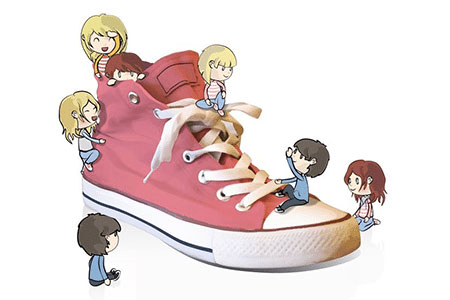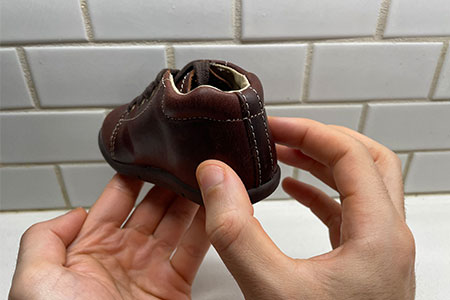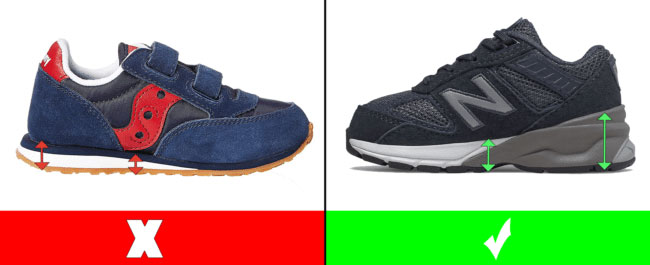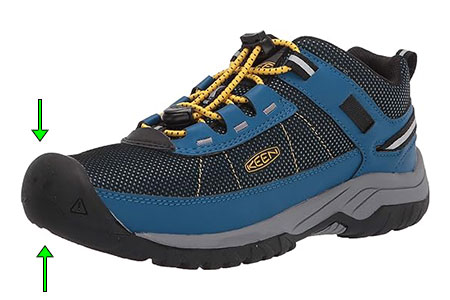Let’s Identify the Different Parts of the Shoe – Get to Know Your Kids’ Shoes

It’s important to know what the different parts of the shoes are called in case your child needs extra support from a specific part of the shoe. For example, physical or occupational therapists might recommend shoes with a firm heel counter or a substantial outsole for children who are experiencing heel or arch pain. Do you know where the heel counter of the shoe is located? Do you know what is considered a substantial outsole? Let’s identify the different parts of the shoe.
Has Your Child Been Diagnosed with a Foot Condition?
Children who have a particular foot condition or are experiencing foot and leg pain need to wear shoes that provide targeted support to certain areas of the feet. I believe that you can strongly benefit from knowing which are the different parts of your kids’ shoes, especially if you have a child that is experiencing foot or leg pain.
When children experience foot pain, they likely need to find a shoe that provides better arch or ankle support. I believe that it’s important for parents to get familiar with which are the different parts of the shoes to be able to significantly reduce or fully eliminate the pain that their kids are experiencing.
Let’s Identify the Different Parts of the Shoes
1️⃣ Heel Counter: This is the back part of the shoe that provides ankle and heel support. The heel counter of the shoe needs to be firm, as the firmer it is, the more support it provides. Take a look at the picture below to identify where the heel counter of the shoe is located:

If your child is experiencing heel pain, it’s important to press on the heel counter of the shoes and make sure it feels firm instead of soft. If you press on the heel counter of the shoes and it feels flimsy or soft, then it means that the shoes won’t provide any type of heel or ankle support. Let’s take a look at the difference between a shoe with a soft heel counter versus a shoe with a firm heel counter:

2️⃣ Substantial Outsole: This is the bottom part of the shoe that provides arch support. It’s important for the shoes to always provide a supportive, substantial outsole to minimize the impact that your kids’ feet take every time they become in contact with the ground. Below you can see the difference between a shoe with a substantial sole versus a shoe with a sole that is too thin and doesn’t provide the correct amount of support:

Another reason why the shoes must provide a substantial outsole is that it helps prevent your child’s shoes from wearing down faster than expected.
3️⃣ Toe cap: This is the front part of the shoe that is often made of rubber or other highly abrasion-resistant materials and provides additional protection from scrapes and sharp hazards. Take a look at the picture below to identify where the toe cap of the shoe is located:

Some children tend to drag their toes to the ground when walking or running that’s why the toe cap of the shoes needs to be durable to prevent the shoes from wearing down.
4️⃣ Toe-Box: This is also the front part of the shoe, but it covers the whole front of the shoe. You might have heard that certain children with wide feet require a shoe with a wider or rounder toe-box, or children with narrow feet require a shoe with a narrower toe-box. Take a look at the picture below to identify where the toe-box of the shoe is located:

Shoes with rounder toe-boxes are the most effective ones when you have to fit an orthotic inside the shoes.
5️⃣ Eyelets: These are the holes where the shoelaces go through. Take a look at the picture to identify where the eyelets of the shoes are located:

6️⃣ Tongue: The tongue of the shoe is a strip of leather or other material located under the laces of a shoe. Sometimes when a child has narrow feet you will hear the shoe fitter recommend a tongue pad to be fitted on the tongue of the shoe. Take a look at the picture below for clarification to identify where the tongue of the shoe is located:

If there is a specific part of the shoe that you are still unclear of where is located please let me know in the comments section below.
